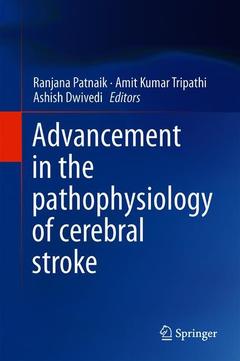Advancement in the Pathophysiology of Cerebral Stroke, 1st ed. 2019

This book provides detailed and comprehensive mechanistic insights of the various risk factors that lead to the ischemic stroke and the novel therapeutic interventions against it. The first section discusses the different ischemic cerebral stroke-induced inflammatory pathways and dysfunctionality of blood-brain barrier. The later sections of the book deals with the role of endoplasmic reticulum stress and mitophagy in cerebral stroke and introduces the different neuroimaging techniques such as Computed tomography (CT), Magnetic resonance imaging (MRI), Positron emission tomography (PET) and Single-Photon emission computed tomography (SPECT) that are used to identify the arterial blockages. The final section comprises of chapters that focus on various neuroprotective strategies and emerging therapeutic interventions for combating stroke pathophysiology. The chapters cover the role of stem cell therapy, the therapeutic effect of low-frequency electromagnetic radiations (LF-EMR), and implications of non-coding RNAs such as micro-RNAs as the biomarkers for diagnosis, prognosis, and therapy in ischemic stroke.
Chapter 1. Cerebral stroke: An Introduction.- Chapter 2. Inflammation, oxidative stress, and neurodegeneration.- Chapter 3. Stroke induced blood brain barrier damage.- Chapter 4. Regulation of calcium ions in ischemic neuronal cell.- Chapter 5. Ischemic stroke induced endoplasmic reticulum stress.- Chapter 6. The role of autophagy in ischemic stroke: friend or foe?- Chapter 7. Critical role of mitochondrial autophagy in cerebral stroke.- Chapter 8. Application of neuroimaging in the identification of the pinpoint location of blockage.- Chapter 9. Emerging role of the electromagnetic field in stroke.- Chapter 10. Stem cell therapies for stroke.- Chapter 11. MicroRNA: Significance to stroke diagnosis, prognosis, and therapy.- Chapter 12. Therapeutic Aspects of Nanomedicines in Stroke Treatment.- Chapter 13. Neuroprotective potential of small molecule phytochemicals against stroke.- Chapter 14. Role of UV irradiation on neuroprotective potential of phytochemicals.- Chapter 15. Post-stroke treatment strategies, management, and rehabilitation.
Prof. Ranjana Patnaik is a Professor in School of Bio-Medical Engineering, Indian Institute of Technology (Banaras Hindu University), Varanasi, India. She has thirty-three years of teaching and Research Experience. Till now, she has authored 15 book chapters and more than 150 research articles in various peer-reviewed journals. She is a member of numerous Boards including Board of Governors, Board of studies and Board of Examiners in different Universities and Institutions. She has received a number of Awards such as Rashtriya Gaurav Award (2014), Best Citizen of India Award (2014), Rajiv Gandhi Excellence Awards (2014), National Award 2011 (by Department of Science and Technology, Govt. of India) for Low Cost Multi-use Hearing Aid and Saraswati Samman (2010). She is a life member of eight Scholarly Societies including SFN, IBRO, IAN, IBNS, FICCI, APS, BNA and FENS. Her areas of interests are focused on Stroke, Heat/Cold Stress, Blood-Brain Barrier, Neurotoxicity, Neurodegeneration, and Neuroprotection.
Dr. Amit Kumar Tripathi is a National-Post-Doctoral Fellow (DST-SERB) in Electrophysiology Lab, School of Biomedical Engineering, IIT (BHU), Varanasi, India. He has done his Doctoral Research from Endocrinology Division, CSIR-Central Drug Research Institute, Lucknow, India. His doctoral research was focused on the mechanistic studies to understand the neuroprotection. He has ten years of research experience on rodent models of various neurological disorders such as transient Middle Cerebral Artery Occlusion (tMCAO), cerebral venous sinuses thrombotic (CVST), Traumatic brain injury (TBI) and Parkinson disease. He has published his research work in various peer-reviewed international journals including, Journal of Biomedical Science and Neuroscience Letter.
Dr. Ashish Diwedi is a Research Associate in Skaggs School of Pharmacy & Pharmaceutical Sciences, Colorado University, Anschutz Medical Campus
Date de parution : 05-2019
Ouvrage de 189 p.
15.5x23.5 cm
Thèmes d’Advancement in the Pathophysiology of Cerebral Stroke :
Mots-clés :
Stroke; Proteasome; Nanoparticle; ER stress; Micro-RNA; Stem cell; Diagnostic Radiology



